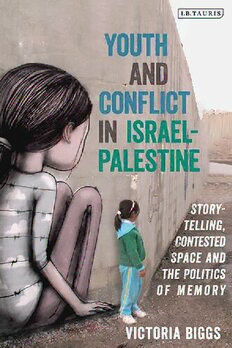
Youth and Conflict in Israel-Palestine: Storytelling, Contested Space and the Politics of Memory PDF
Preview Youth and Conflict in Israel-Palestine: Storytelling, Contested Space and the Politics of Memory
Youth and Conflict in Israel-Palestine ii Youth and Conflict in Israel-Palestine Storytelling, Contested Space and the Politics of Memory Victoria Biggs I.B. TAURIS Bloomsbury Publishing Plc 50 Bedford Square, London, WC1B 3DP, UK 1385 Broadway, New York, NY 10018, USA BLOOMSBURY, I.B. TAURIS and the I.B. Tauris logo are trademarks of Bloomsbury Publishing Plc First published in Great Britain 2021 Copyright © Victoria Biggs, 2021 Victoria Biggs has asserted her right under the Copyright, Designs and Patents Act, 1988, to be identified as Author of this work. For legal purposes the Acknowledgements on p.viii constitute an extension of this copyright page. All rights reserved. No part of this publication may be reproduced or transmitted in any form or by any means, electronic or mechanical, including photocopying, recording, or any information storage or retrieval system, without prior permission in writing from the publishers. Bloomsbury Publishing Plc does not have any control over, or responsibility for, any third-party websites referred to or in this book. All internet addresses given in this book were correct at the time of going to press. The author and publisher regret any inconvenience caused if addresses have changed or sites have ceased to exist, but can accept no responsibility for any such changes. A catalogue record for this book is available from the British Library. A catalog record for this book is available from the Library of Congress. ISBN: HB: 978-1-8386-0490-5 ePDF: 978-1-8386-0491-2 eBook: 978-1-8386-0492-9 Typeset by Integra Software Services Pvt. Ltd. To find out more about our authors and books visit www.bloomsbury.com and sign up for our newsletters. For my parents, who always caved to child-me’s demand for more stories vi Contents Acknowledgements viii 1 Once upon an intifada 1 2 Telling stories in tear gas 27 3 Language and the hidden landscape 43 4 Violence in the narration of self and other 77 5 Forbidden histories in contested spaces 113 6 Happily ever after? Telling endings 147 Notes 173 Bibliography 184 Index 193 Acknowledgements Like all the best stories, this project was a collaborative effort. I would like to thank Bertrand Taithe, Alison Jeffers, Peter Gatrell and Jenny Carson for their guidance as the research was in progress; Jenny Hughes and Dawn Chatty for posing challenging questions that helped to make this a better book; Sophie Rudland, my editor, for both her thoughtful input on the manuscript and her phenomenal patience with my aversion to deadlines; and Julien Malland (also known as Seth Globepainter), who gave kind permission for me to use his artwork for the cover. The Council for British Research in the Levant gave me a generous visiting research scholarship to support my fieldwork. Sima Salman and her mother Hind provided equally generous allowances of tea and cake; this manuscript came to life in their café and would not have been possible without all the limon ma na’ana. My landlord Issa smoothed out many practical difficulties during my years in Bethlehem (notwithstanding the time he sent an unannounced Orthodox priest to ritually bless my apartment just as I was drifting into a nap with no trousers on). My language teachers Marwa and Malka made sure I was well prepared for fieldwork. Various people and organizations in Israel-Palestine went out of their way to help me arrange it, particularly Toine and Rania at Ṣumūd Story House; Abdelfatteh, Taghreed and Amira at Al-Rowwad Centre; the youth work team at Neve Shalom/Wahat as-Salaam, staff at the Jerusalem office of Kids4Peace; and Issa from Youth Against Settlements. I am especially grateful to Myron Joshua for both his assistance with participant recruitment and being a remarkably compassionate and astute listener whose questions enriched my work. Other friends and neighbours contributed to the research in different ways: Shai Abraham, Sarah Ali, Majdi Amro, Rachel Barenblat, Olivier Catel, Nadja Abia, Alison Conyers, Mitchell Cohen, Shahar Colt, Sameeha Elwan, Bayan Haddad, Dalia Halaq, Shuli H., Fatma Kassem, Wala’ Qasieh, Brant Rosen, Jenny Salameh, Zayneb al-Shalalfeh, Asmaa Shweiky, Hannah Spiegel, Elana Weiner and Tsvia Zanger-Horesh. My heartfelt thanks to Shira Zeharia, my eleventh- hour friend, for helping me to create a better ending. Acknowledgements ix Faith Cecelia Jacobs has my special gratitude for the limitless kindness, patience and wisdom she showed to me even when her own circumstances were very challenging. It is a source of grief that she died before she could see this book, which owes so much to her support (and timely Marmite deliveries). The return to England was made smoother through the unfailing encouragement of my parents, and the kindness of Sobia Asad Zuberi, Miruna Belea, Daisy Black, Danni and Johan Brennand, David Hearne, Simon R. and Candace Simpson. My colleagues and mentors at the University of Sheffield, Cathy Shrank and Mary Vincent, helped me to find my feet as an academic. Their advice and support have been invaluable. Most importantly of all, I would like to thank the young people from Israel and Palestine for their generosity in telling me their stories, their curiosity and their critiques of and insights into the project. It was a delight and an honour to work with them.
